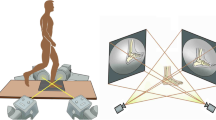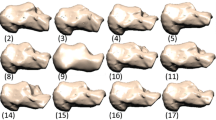Abstract
Internal strain is known to be one of the contributors to plantar soft tissue damage. However, due to challenges related to measurement techniques, there is a paucity of research investigating the strain within the plantar soft tissue during daily weight-bearing activities. Therefore, the main aim of this study was to develop a non-invasive method for predicting heel pad strain during loading. An ultrasound indentation technique along with a mathematical model was employed to calculate visco-hyperelastic structural coefficients from the results of cyclic-dynamic indentation and stress-relaxation tests. Subject-specific structural coefficients of heel pads were calculated from twenty participants along with the assessment of plantar pressure. The average difference between the predicted and the measured force during the cyclic-dynamic indentation test was only 5.8%. Moreover, the average difference between the predicted and the in vivo strain during walking was 14%. No statistically significant correlation was observed between maximum strain and peak plantar pressure during walking; indicating that the measurement of strain along with plantar pressure can improve our understanding of the mechanical behaviour of the plantar soft tissue.




Similar content being viewed by others
References
Atlas, E., Z. Yizhar, and A. Gefen. The diabetic foot load monitor: a portable device for real-time subject-specific measurements of deep plantar tissue stresses during gait. J. Med. Device. 2:011005, 2008.
Behforootan, S., P. Chatzistergos, N. Chockalingam, and R. Naemi. A clinically applicable non-invasive method to quantitatively assess the visco-hyperelastic properties of human heel pad with implications for assessing the risk of mechanical trauma. J. Mech. Behav. Biomed. Mater. 68:287–295, 2017.
Behforootan, S., P. Chatzistergos, R. Naemi, and N. Chockalingam. Finite element modelling of the foot for clinical applications: a systematic review. Med. Eng. Phys. 39:1–11, 2017.
Bennett, P., A. Stocks, and D. Whittam. Analysis of risk factors for neuropathic foot ulceration in diabetes mellitus. J Am Pod. Med Assoc 86:335–337, 1996.
Boulton, A. J. The diabetic foot: a global view. Diabetes. Metab. Res. Rev. 16:2–5, 2000.
Chatzistergos, P. E., R. Naemi, and N. Chockalingam. A method for subject-specific modelling and optimisation of the cushioning properties of insole materials used in diabetic footwear. Med. Eng. Phys. 37:531–538, 2015.
Chatzistergos, P. E., R. Naemi, L. Sundar, A. Ramachandran, and N. Chockalingam. The relationship between the mechanical properties of heel-pad and common clinical measures associated with foot ulcers in patients with diabetes. J. Diabetes Complicat. 28:488–493, 2014.
Chen, W.-M., T. Lee, P. V.-S. Lee, J. W. Lee, and S.-J. Lee. Effects of internal stress concentrations in plantar soft-tissue–a preliminary three-dimensional finite element analysis. Med. Eng. Phys. 32:324–331, 2010.
Chokhandre, S., J. P. Halloran, A. J. van den Bogert, and A. Erdemir. A three-dimensional inverse finite element analysis of the heel pad. J. Biomech. Eng. 134:031002, 2012.
Crawford, F., M. Inkster, J. Kleijnen, and T. Fahey. Predicting foot ulcers in patients with diabetes: a systematic review and meta-analysis. QJM 100:65–86, 2007.
Davis, B. L. Medical hypotheses foot ulceration : hypotheses concerning shear and vertical forces acting on adjacent regions of skin. Med. Hypotheses 40:44–47, 1993.
Delbridge, L., G. Ctercteko, C. Fowler, T. S. Reeve, and L. P. Le Quesne. The aetiology of diabetic neuropathic ulceration of the foot. Br. J. Surg. 72:1–6, 1985.
Dinh, T. L., and A. Veves. A review of the mechanisms implicated in the pathogenesis of the diabetic foot 4:154–159, 2005.
Erdemir, A., M. L. Viveiros, J. S. Ulbrecht, and P. R. Cavanagh. An inverse finite-element model of heel-pad indentation. J. Biomech. 39:1279–1286, 2006.
Gefen, A. Plantar soft tissue loading under the medial metatarsals in the standing diabetic foot. Med. Eng. Phys. 25:491–499, 2003.
Gefen, A., and E. Linder-Ganz. Diffusion of ulcers in the diabetic foot is promoted by stiffening of plantar muscular tissue under excessive bone compression. Orthopade 33:999–1012, 2004.
Gefen, A., M. Megido-Ravid, and Y. Itzchak. In vivo biomechanical behavior of the human heel pad during the stance phase of gait. J. Biomech. 34:1661–1665, 2001.
Hsu, Y.-C., Y.-W. Gung, S.-L. Shih, C.-K. Feng, S.-H. Wei, C.-H. Yu, and C.-S. Chen. Using an optimization approach to design an insole for lowering plantar fascia stress–a finite element study. Ann. Biomed. Eng. 36:1345–1352, 2008.
Hsu, T.-C., Y.-S. Lee, and Y.-W. Shau. Biomechanics of the heel pad for type 2 diabetic patients. Clin. Biomech. (Bristol, Avon) 17:291–296, 2002.
Hsu, T. C., W. C. Tsai, T. Y. Hsiao, F. Y. Tseng, Y. W. Shau, C. L. Wang, and S. C. Lin. Diabetic effects on microchambers and macrochambers tissue properties in human heel pads. Clin. Biomech. 24:682–686, 2009.
Klaesner, J. W., M. K. Hastings, D. Zou, C. Lewis, and M. J. Mueller. Plantar tissue stiffness in patients with diabetes mellitus and peripheral neuropathy. Arch. Phys. Med. Rehabil. 83:1796–1801, 2002.
Landsman, A. S., D. F. Meaney, R. S. Cargill, E. J. Macarak, and L. E. Thibault. 1995 William J. Stickel Gold Award. High strain rate tissue deformation. A theory on the mechanical etiology of diabetic foot ulcerations. J. Am. Podiatr. Med. Assoc. 85:519–527, 1995.
Lavery, L. A. Practical criteria for screening patients at high risk for diabetic foot ulceration. Arch. Intern. Med. 158:157–162, 1998.
Loerakker, S., E. Manders, G. J. Strijkers, K. Nicolay, F. P. T. Baaijens, D. L. Bader, and C. W. J. Oomens. The effects of deformation, ischemia, and reperfusion on the development of muscle damage during prolonged loading. J. Appl. Physiol. 111:1168–1177, 2011.
Loerakker, S., A. Stekelenburg, G. J. Strijkers, J. J. M. Rijpkema, F. P. T. Baaijens, D. L. Bader, K. Nicolay, and C. W. J. Oomens. Temporal effects of mechanical loading on deformation-induced damage in skeletal muscle tissue. Ann. Biomed. Eng. 38:2577–2587, 2010.
Miller-young, J. E., N. A. Duncan, and G. Baroud. Material properties of the human calcaneal fat pad in compression: experiment and theory. J. Biomech. 35:1523–1531, 2002.
Mueller, M. Etiology evaluation, and treatment of the neuropathic foot. Crit Rev Phys Rehabil Med 3:309, 1992.
Naemi, R., P. P. Chatzistergos, and N. Chockalingam. A mathematical method for quantifying in vivo mechanical behaviour of heel pad under dynamic load. Med. Biol. Eng. Comput. 54:341–350, 2016.
Naemi, R., P. Chatzistergos, L. Sundar, N. Chockalingam, and A. Ramachandran. Differences in the mechanical characteristics of plantar soft tissue between ulcerated and non-ulcerated foot. J. Diabetes Complicat. 30(7):1293–1299, 2016.
Naemi, R., P. Chatzistergos, S. Suresh, L. Sundar, N. Chockalingam, and A. Ramachandran. Can plantar soft tissue mechanics enhance prognosis of diabetic foot ulcer? Diabetes Res. Clin. Pract. 126:182–191, 2017.
Natali, A. N., C. G. Fontanella, and E. L. Carniel. Constitutive formulation and analysis of heel pad tissues mechanics. Med. Eng. Phys. 32:516–522, 2010.
Petre, M., A. Erdemir, and P. R. Cavanagh. An MRI-compatible foot-loading device for assessment of internal tissue deformation. J. Biomech. 41:470–474, 2008.
Petre, M., A. Erdemir, V. P. Panoskaltsis, T. A. Spirka, and P. R. Cavanagh. Optimization of nonlinear hyperelastic coefficients for foot tissues using a magnetic resonance imaging deformation experiment. J. Biomech. Eng. 135:61001–61012, 2013.
Stekelenburg, A., D. Gawlitta, D. L. Bader, and C. Oomens. Deep tissue injury: how deep is our understanding? J. Phys. Med. Rehabil. 89:1410–1413, 2008.
Tao, K., D. Wang, C. Wang, X. Wang, A. Liu, C. J. Nester, and D. Howard. An in vivo experimental validation of a computational model of human foot. J. Bionic Eng. 6:387–397, 2009.
Yarnitzky, G., Z. Yizhar, and A. Gefen. Real-time subject-specific monitoring of internal deformations and stresses in the soft tissues of the foot: a new approach in gait analysis. J. Biomech. 39:2673–2689, 2006.
Zabihollahy, F., B. M. Trindade, Y. Ono, and E. D. Lemaire. Continuous monitoring of mechanical properties of plantar soft tissue for diabetic patients using wearable ultrasonic and force sensors. IEEE Trans. 2016.
Acknowledgment
Authors would like to acknowledge the Staffordshire University Research Studentship which supported the completion of this study.
Author information
Authors and Affiliations
Corresponding author
Additional information
Associate Editor Arash Kheradvar oversaw the review of this article.
Rights and permissions
About this article
Cite this article
Behforootan, S., Chatzistergos, P.E., Chockalingam, N. et al. A Simulation of the Viscoelastic Behaviour of Heel Pad During Weight-Bearing Activities of Daily Living. Ann Biomed Eng 45, 2750–2761 (2017). https://doi.org/10.1007/s10439-017-1918-1
Received:
Accepted:
Published:
Issue Date:
DOI: https://doi.org/10.1007/s10439-017-1918-1




